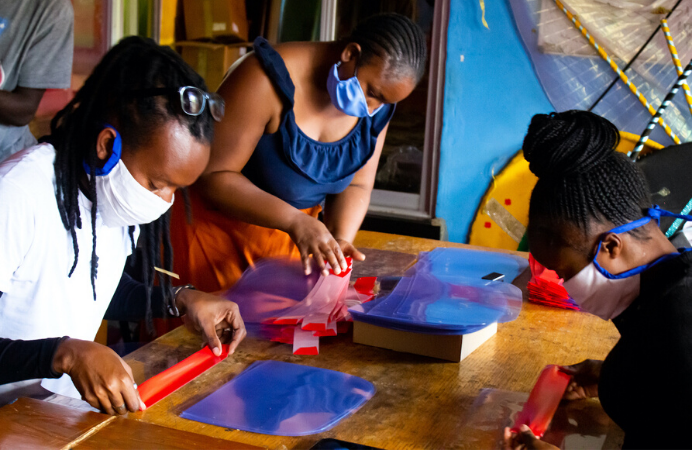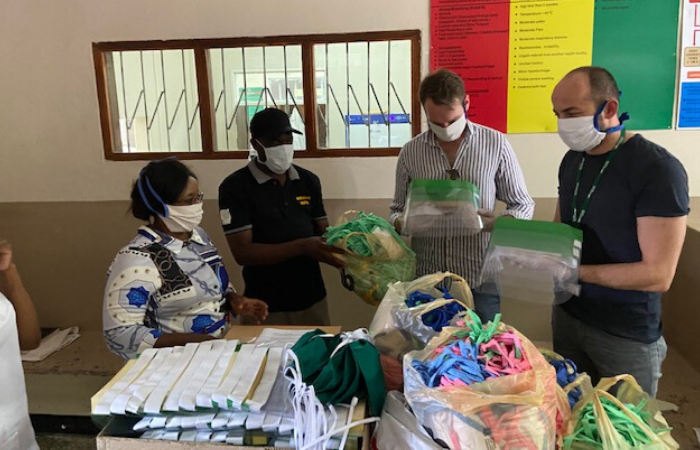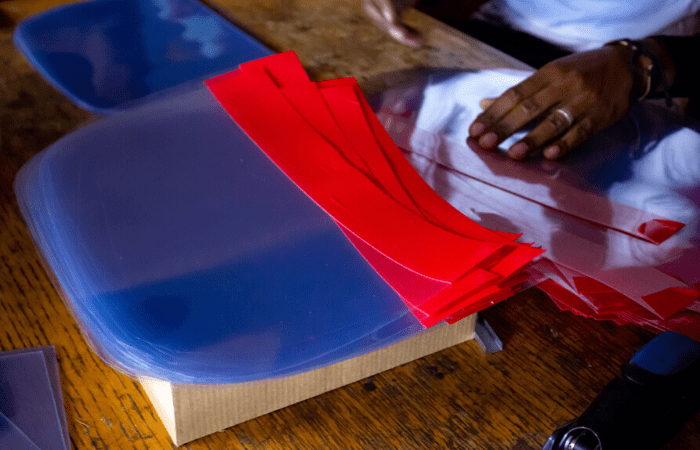
In the African nation of Zambia, UAB School of Medicine Professor Albert Manasyan, MD, conducts perinatal research, which is focused on the critical few weeks before and after birth. After coming back to the main UAB campus in March, he returned to Zambia with a plan to create personal protective equipment (PPE) in response to the COVID-19 pandemic. Dr. Manasyan’s plan to produce face shields for front-line medical staff has quickly grown into a large-scale project.
Dr. Manasyan, an associate professor at the UAB Division of Neonatology, since 2008 has worked with the Centre for Infectious Disease Research in Zambia (CIDRZ), a non-governmental organization founded in 2001 by UAB. It was created to conduct research in HIV, tuberculosis, and maternal, newborn, and child health, and the now-standalone group still hosts UAB Medicine faculty, staff, fellows, and interns.
While back at UAB in March 2020, he spoke to participants of perinatal grand rounds (a formal meeting at which doctors discuss clinical cases), and Dr. Manasyan learned that UAB cancelled all work-related international travel. Because he lives and works full-time in Lusaka, Zambia, he was allowed to return. Already thinking of ways he could make PPE to help the Zambian Ministry of Health combat the COVID-19 pandemic, Dr. Manasyan happened by chance upon the answer to a design problem. He was in the office of Waldemar Carlo, MD, director of the UAB Division of Neonatology.
“Many organizations were making cotton face masks that anyone can use, so I wanted to create PPE for frontline workers who are treating and screening patients for COVID-19,” Dr. Manasyan says. “I knew that some companies use 3-D printers to make face shields, but I was concerned that their process is not replicable, as we don’t have a 3-D printer in Zambia, and we also don’t have a plastic or metal manufacturing company that can print the molds. One morning during my visit, Dr. Carlo, who has been my mentor since 2008, walked into his office with a box of face shields, and I noticed the foam construction of those devices. That’s when I made the connection – we could fabricate something locally with simple, available materials. It was just a matter of attaching PVC (a type of plastic) to a foam fitting.”

Innovation Meets Charity
Once he was back in Zambia, Dr. Manasyan and a few friends began crafting face shields at his home, using only PVC, foam, tape, elastic, and staples. It was an efficient do-it-yourself project, with the group constructing and donating 1,000 face shields to the Zambia Ministry of Health in a short time. Dr. Manasyan says that, although the group was pleased with its progress, they could not have guessed how quickly the effort would grow into a much larger project.
“We wanted to provide 2,000 pieces of PPE, and each one costs 50 cents to make,” Dr. Manasyan says. “Our goal was to raise $1,000 through a crowd-funding platform, and in 24 hours we had received $1,300. We thought, okay, that’s a good start. Then the Minister of Health, Dr. Chitalu Chilufya, tried on one of the face shields during a live television broadcast. After that, we immediately began getting requests from government health facilities throughout the country, so our production target jumped from 2,000 to 30,000. We realized that, since we all have full-time jobs, we would never get this project done on weekends. So I called on some talented people.”
The talent Dr. Manasyan refers to is a group of young volunteers from Barefeet Theatre, a group founded in 2006 in Lusaka that educates and supports at-risk children through its arts programs. The organization was founded by former street children as a response to the plight of young people living on Zambia’s streets. Along with various education and development services related to children’s rights issues, the group offers help for those who are vulnerable to health problems such as HIV/AIDS, drugs and alcohol, violence, and sexual abuse. It also hosts the annual Christmas Show and the Barefeet Youth Arts Festival, which are two of the largest arts events in Zambia.
“I’ve had the privilege of working with these young people for two years,” Dr. Manasyan says. “I’m now on the Barefeet Theatre board of directors. I asked them for some help on this project, and since that day, seven volunteers from the Barefeet team have been making the PPE. This small, hard-working group assembles 700-800 face shields per day. It is truly inspiring. At this point, I don’t think there is anything they cannot do.”
Trial and Error
Even with a device designed so that anyone can assemble it, the production line still faced obstacles that called for trouble-shooting and at least one science experiment.
“At first we worked with a company to cut the PVC with a laser cutter, before we learned that the process can create toxic fumes,” Dr. Manasyan says. “So now the Barefeet Theatre group is hand-cutting the material and actually doing it much faster. Then they glue foam fittings around the shield portions. In the first few tries, we were shocked to discover that too much glue will eat through the PVC. This major issue required a bit of a science experiment to solve. By trial and error, we found that a very light brushing of glue at three points will create enough adhesion without destroying the PVC. After that we began adding a colored tape strip to hide those glue spots. It adds only pennies to the cost and makes the device look more polished and professional.”
As a do-it-yourself enterprise, the PPE production team can’t rely on research and development departments or focus groups, so they adapt in the field. The new and improved face shields with the colored tape, for example, brought an odd technical surprise.
“We received a message from the Anesthesiology Department,” Dr. Manasyan says. “They said ‘Please use a different color tape.’ The department explained that patients recovering from anesthesia react poorly to certain colors. I did not expect that kind of feedback, but the problem was easily solved.”

GoFundMe Help
A by-product of the project is its benefit to the country from the use of local services and materials from local producers. That’s an important factor, considering that the new production goal of 30,000 PPE pieces calls for a $20,000 GoFundMe effort. Dr. Manasyan says he has been overwhelmed by the generosity of those who are contributing and those providing free or discounted materials or distribution services.
As of May 8, 2020, the project has distributed more than 15,600 face shields to health care facilities in various cities and provinces in Zambia and along its borders. In addition to the face shields, the team also plans to make 10,000 face masks to be distributed to hospital and clinic patients in Zambia.
“This experience points to many areas of accomplishment and potential,” Dr. Manasyan says. “We can see the global reach of UAB Medicine. There is the generosity of donors to the GoFundMe platform; many people are sending amounts in the hundreds of dollars. We have the hands-on dedication of the young people from Barefeet Theatre. It’s been amazing to witness the success that has resulted from this collaboration and care.”
A donation as small as $5 is enough to make 10 face shields or cotton facemasks. To make a contribution, visit Face Shields for Zambia here.
